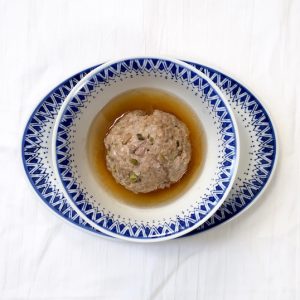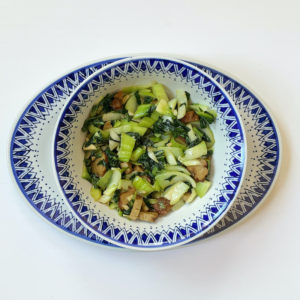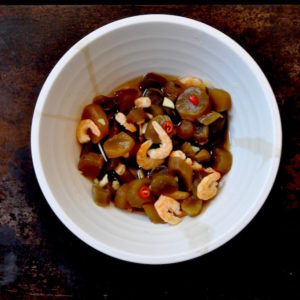Omelet with Chinese pickled vegetable
Soaring fuel prices are forcing many people, myself included, to reconsider everything we were taught about “good cooking.” Especially now, when we would normally be starting to prepare stews, bone-in roasts, and soups, dishes demanding hours of slow cooking.

Gourds. Official harbinger of Fall. Well, these and pumpkin-spiced coffee drinks, which will never, ever appear on the IK. (Gourds photographed at Berkeley Bowl West.)

Some people are coping with fuel costs by investing in pressure cookers or Instant Pots. These items are ideal if you are among those returning to work outside the home and/or have large families to feed. I do not fall into either category.

In lieu of pressure cookers or Instant pots, I give you cast iron. These pans are small; the larger one holds two eggs. The smaller is just big enough to hold a single egg.
The IK hasn’t escaped inflation’s impact. Last week I spent $43 on three pork chops. Yes, the chops came from organic, humanely raised pigs. The farm was local. And yes, three large pork chops go a long way in our household of two measly appetites.

No pork chop pix. Instead, peppers. More fallish food.
Still…..Forty-three dollars is a lot of money.
So what to do? Or, more pointedly, what to eat?

The last of the tomatoes.
Until this economic crisis passes–and it will, eventually–we might consider putting aside what we were taught about best kitchen practices. Maybe not at every meal, but sometimes. This is a personal decision, but those of us who wouldn’t be caught dead buying skinless, boneless cuts or microwaving vegetables might rethink our snobbish ways. And now is a good time to recall miso, before it was slathered on cookies and stirred into gin cocktails, was meant for soup.
Moving along to the star of today’s post.

Today’s recipe, omelet with Chinese pickled vegetable, is less about specifics and more about concept. You hardly need me to give you omelet-making instructions. You may need a reminder concerning the egg’s possibilites. The world is a distracting place right now, and the distractions are not pleasant. So, omelet with Chinese pickled vegetable.

The result of using eggs from different cartons.
Eggs, even organic ones, are stil cheap. They also cook quickly. Further, there are dozens of ways to prepare them: boiling, frying, poaching, scrambling, over easy, hard boiled. You can make a frittata, a souffle, or do as the French do and add them to your leftovers, in which case they’re called restes. You can eat your egg plain, or add vegetables, cheese, or meat.

Chinese pickled vegetable is available in Asian markets. It is sold in ceramic containers and foil packets. For easy of explanation, we’re sticking with the packets, which are sold in either 12 ounce/350gram or 2.5 ounce/70 gram sizes.

The vegetable itself is a type of fermented mustard green. The closest Western food I can compare it to is the American pickle relish often served alongside hamburgers. Don’t be put off by pickled vegetable’s appearance–it really is delicious. And it’s cheap.

Some people like to rinse pickled vegetable before cooking with it. Taste a bit and decide for yourself. If you want to rinse, empty contents of package in a colander, gently rinse, and pat dry with paper towel. (this assumes you’re using the small packages.) If the vegetables tastes okay as is, it’s ready to use. Any unused amount may be saved in the fridge, where it keeps for at least a month.

Seal any unused pickle with this type of clip. Well, any clip you like. These make nice pictures.
Here is a link to Just Asian Food, an online market carrying a brand of pickled vegetable I use often. I have no association with this market. They don’t know I’m linking to them.
Omelet with Chinese Pickled Vegetable may be eaten with rice, noodles or toast. I eat it with rice. This omelet is best the day it’s made, but will hold in a refrigerated container up to three days.

Omelet with Chinese Pickled Vegetable
prep time: 10 minutes, a bit more if making rice
yield: feeds one. Easily scaled upward
Find Chinese pickled vegetable in Asian markets in the chiller aisle, or see the link above to order it online.
I used a small cast iron pan to make a two-egg omelet. I also made rice. If you are making rice to accompany your omelet, start it now.
peanut or grapeseed oil, for the pan
2 eggs
One 2.5 ounce/70 gram package Chinese pickled vegetable, rinsed if desired
One scallion, sliced thinly
a little finely sliced garlic (optional)
Crack eggs in a small bowl. Open packet of Chinese pickled vegetable and taste a piece. If you want to rinse it, do so in a colander and pat it dry with paper towel. Add the vegetable to the eggs and stir with a fork to blend.
Heat cast iron or nonstick pan over medium high heat and add oil. Once oil is warm, pour in eggs. Cook how you like your omelet.
I like my eggs just done, and cook accordingly.
Eat with rice, bread, or however you like your eggs. The omelet may be refrigerated up to three days in a covered container. Do not freeze.
Notes:
You can also make this omelet with sesame oil.
An omelet may be filled with a wide variety of ingredients: vegetables, dairy, or proteins. Cheeses, a spoonful of creme fraiche or sour cream, chopped ham, minced onion or green onion, minced red pepper, bacon, smoked fish, sauteed mushrooms, cooked spinach, breadcrumbs….the list is nearly endless. Chinese picked vegetable is one suggestion.





